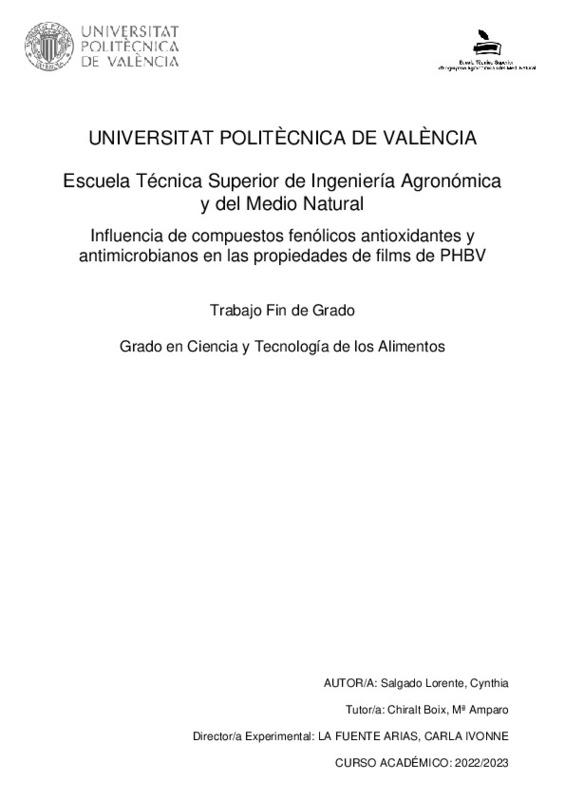|
Resumen:
|
[ES] Se han obtenido films biodegradables de PHBV, con incorporación (5% en el film) de ácido ferúlico, vainillina y catequina, con propiedades antioxidantes y antimicrobianas, mediante
mezclado en fundido y moldeo por ...[+]
[ES] Se han obtenido films biodegradables de PHBV, con incorporación (5% en el film) de ácido ferúlico, vainillina y catequina, con propiedades antioxidantes y antimicrobianas, mediante
mezclado en fundido y moldeo por compresión. Los films se han caracterizado en su comportamiento térmico por calorimetría diferencial de barrido y termogravimetría para
conocer el efecto de los fenoles sobre las propiedades del polímero. Se han caracterizado también sus propiedades mecánicas, de barrera al vapor de agua y al oxígeno y sus propiedades ópticas (color y transparencia). Los resultados indicaron que los compuestos fenólicos interfieren en la cristalización del PHBV, formando cristales de menor tamaño, con punto de fusión más bajo, y con menor cristalinidad global. La estabilidad térmica del material se vio poco afectada por la incorporación de los fenoles. La catequina y el ácido ferúlico tuvieron un efecto antiplastificante en el polímero (aumento la temperatura de transición vítrea: Tg), potenciando la rigidez de los films y su capacidad de barrera al vapor de agua y al oxígeno y reduciendo su extensibilidad. La vainillina, por el contrario, tuvo un efecto plastificante en el polímero (descenso de la Tg), disminuyendo su rigidez y resistencia a la fractura y aumentando su permeabilidad al vapor de agua. Todos los films de PHBV mejoraron en su capacidad de barrera al oxígeno por el efecto secuestrante de los compuestos antioxidantes. Son necesarios más estudios para verificar las propiedades activas de los films para el envasado en alimentos.
[-]
[EN] Biodegradable PHBV films, with incorporation (5%) of ferulic acid, vanillin and catechin with
antioxidant and antimicrobial properties, have been obtained by melt blending and compression
molding. The films have ...[+]
[EN] Biodegradable PHBV films, with incorporation (5%) of ferulic acid, vanillin and catechin with
antioxidant and antimicrobial properties, have been obtained by melt blending and compression
molding. The films have been characterized in their thermal behavior by differential scanning
calorimetry and thermogravimetry to know the effect of phenols on the properties of the
polymer. Mechanical and barrier properties to water vapour and oxygen as well as optical
properties (colour and transparency) were also characterized in the films. The results indicate
that phenolic compounds interfere with PHBV crystallization, forming smaller crystals with a
lower melting point, although with little significant effect on overall crystallinity. The thermal
stability of the material was little affected by the incorporation of phenols. Catechin and ferulic
acid had an anti-plasticising effect on the polymer (increasing the glass transition temperature:
Tg), enhancing the stiffness of the films and their barrier capacity to water vapour and oxygen
and reducing their extensibility. Vanillin, on the other hand, had a plasticising effect on the
polymer (decrease in Tg), decreasing its stiffness and resistance to fracture and increasing its
permeability to water vapour. All PHBV films improved in their oxygen barrier capacity due to
the scavenging effect of the antioxidant compounds. Further studies are needed to verify the
active properties of the films for food packaging applications.
[-]
|







